Abstract
Administration of pertussis vaccine, consisting of whole, killed Bordetella pertussis organisms, causes hyperinsulinemia and enhanced secretion of insulin in response to a variety of secretagogues in rats and mice. In examining the time course and properties of this phenomenon, we discovered two distinct and separate effects of the bacteria on glucose and insulin levels in mice. First, a heat-stable (80 degrees C for 30 min) component causes a brief hyperinsulinemia which is +measureable by 1 h, maximal at 8 h, and ends in less than 48 h. This effect appears to be due to B. pertussis endotoxin, is mimicked by Escherichia coli endotoxin, and is associated with a transient, mild hypoglycemia. Second, there is a heat-labile component of the B. pertussis organism which induces a sustained (greater than 14 days), dose-dependent hyperinsulinemia which reaches a maximum at 5 to 7 days and has no associated hypoglycemia. The two effects are further distinguishable in that the early, endotoxin-induced hyperinsulinemia exhibits the normal suppressibility by exogenous epinephrine, whereas epinephrine markedly enhances the hyperinsulinemia occurring at 7 days. These two effects of B. pertussis appear to be mediated by different mechanisms and may be important in the well-recognized reactogenicity of pertussis vaccine in humans.
Full text
PDF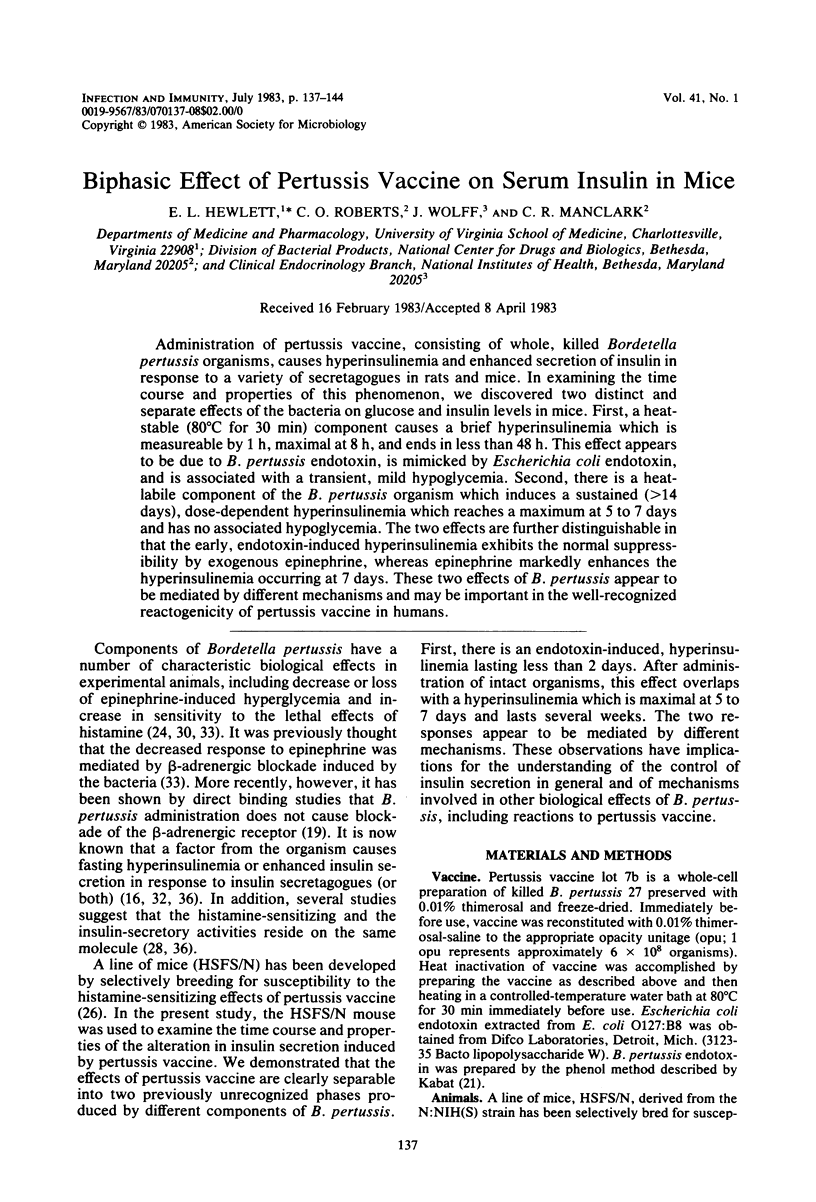
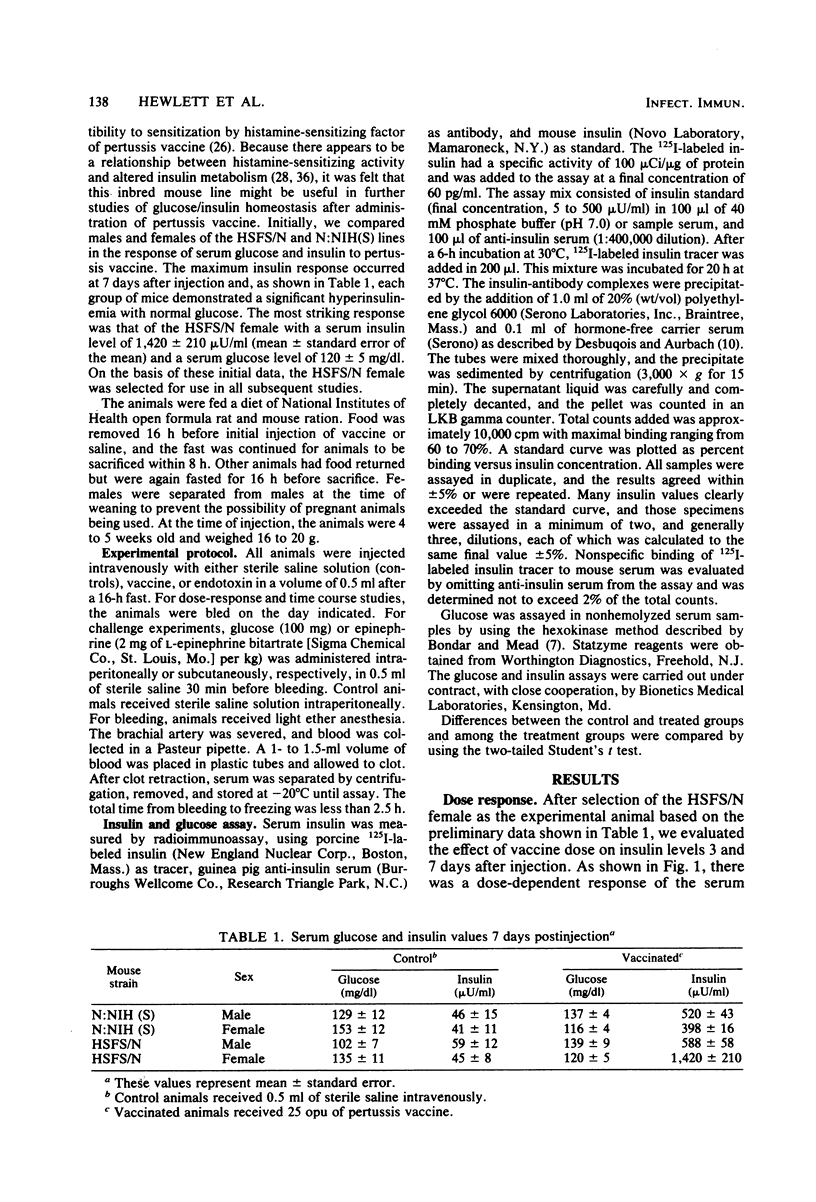
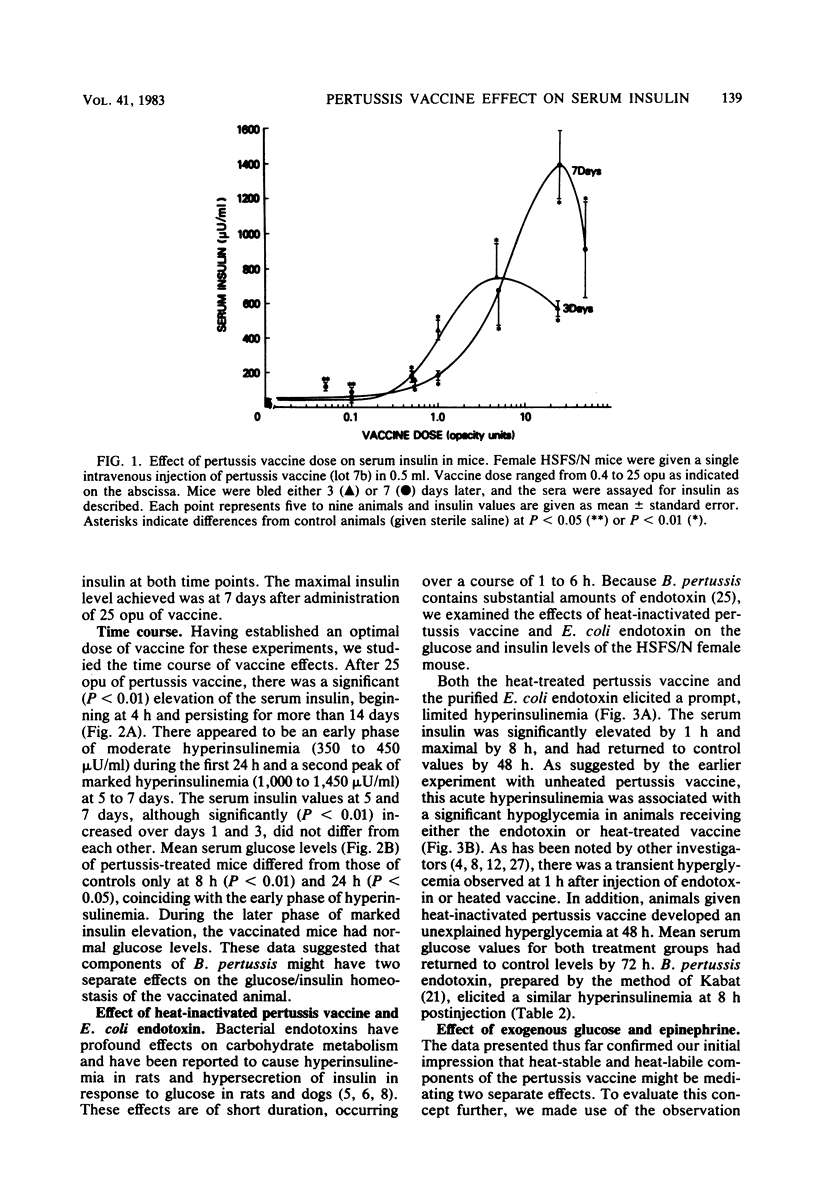
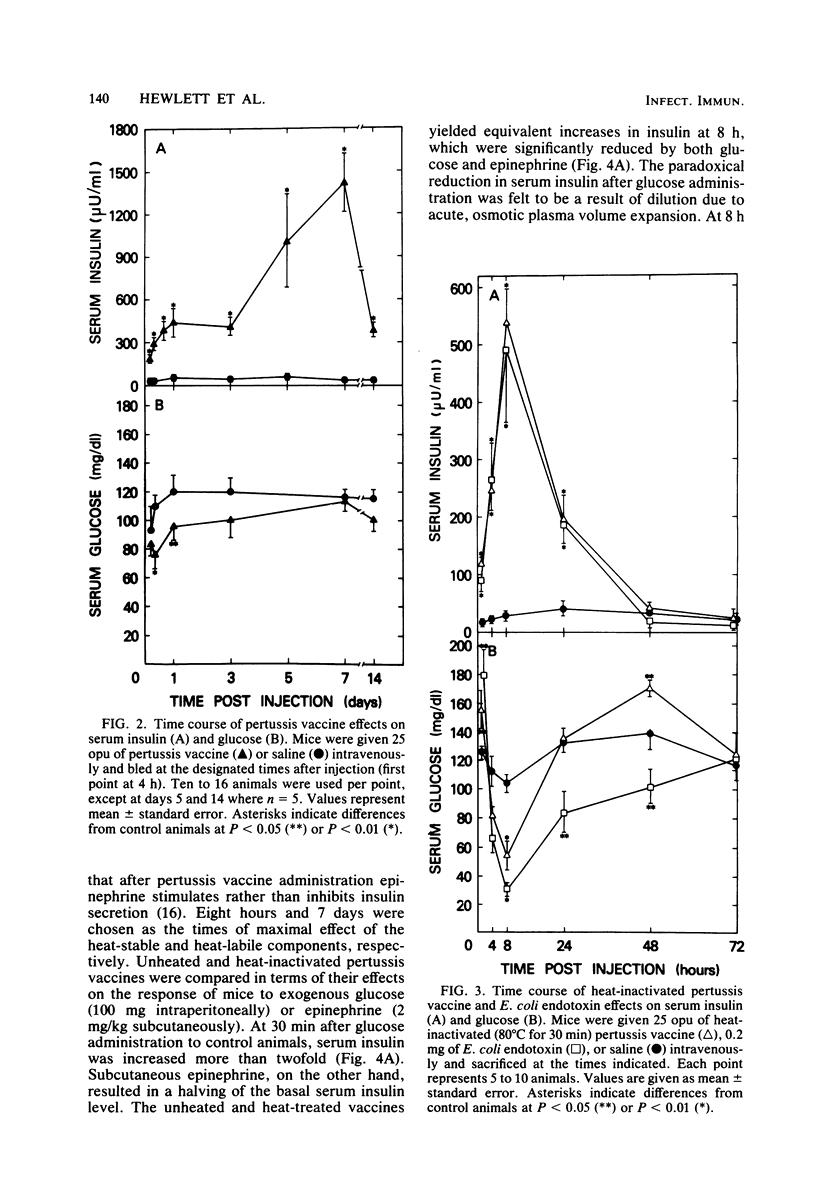
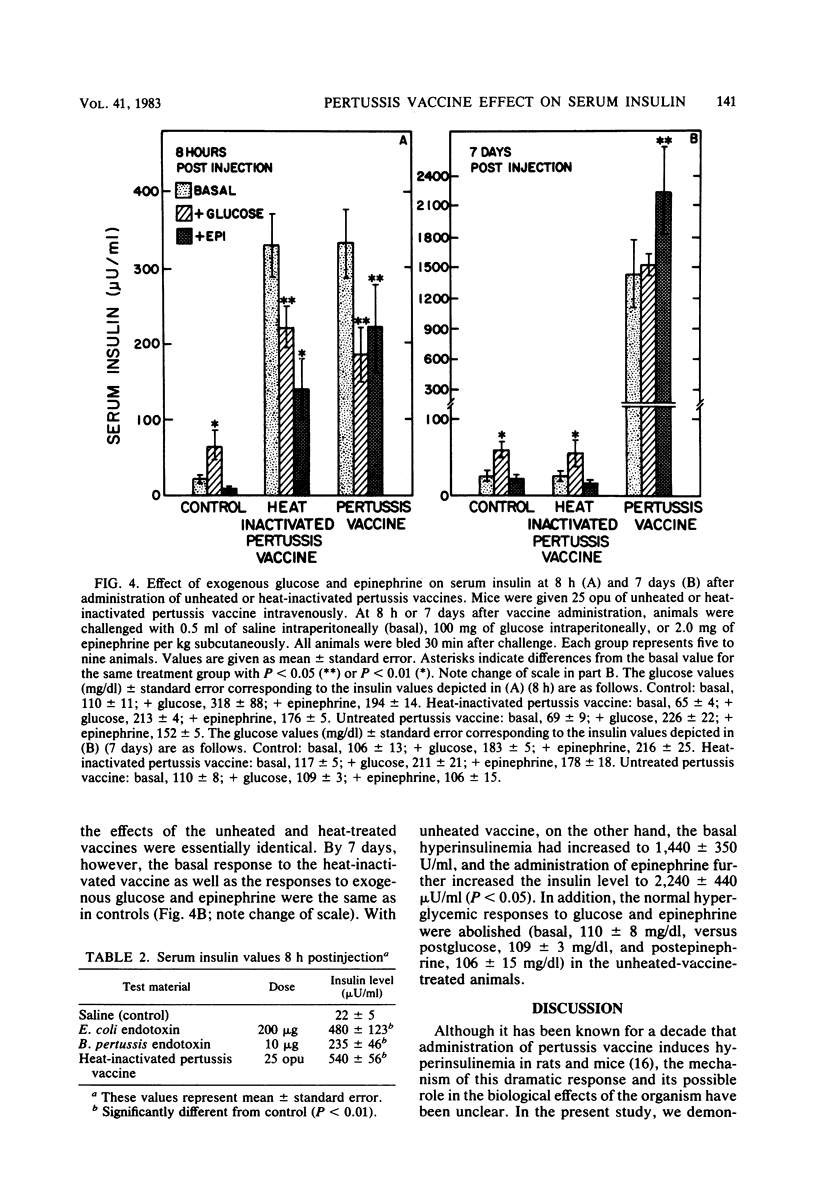
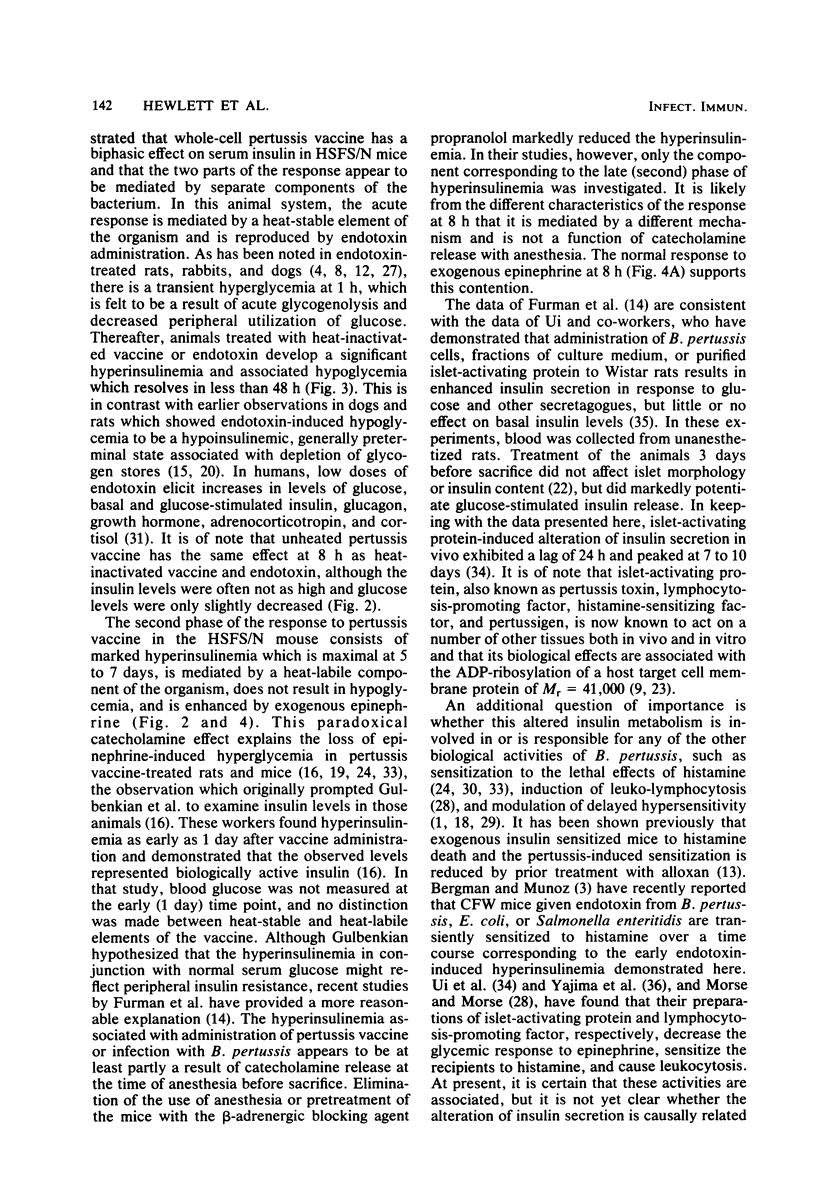
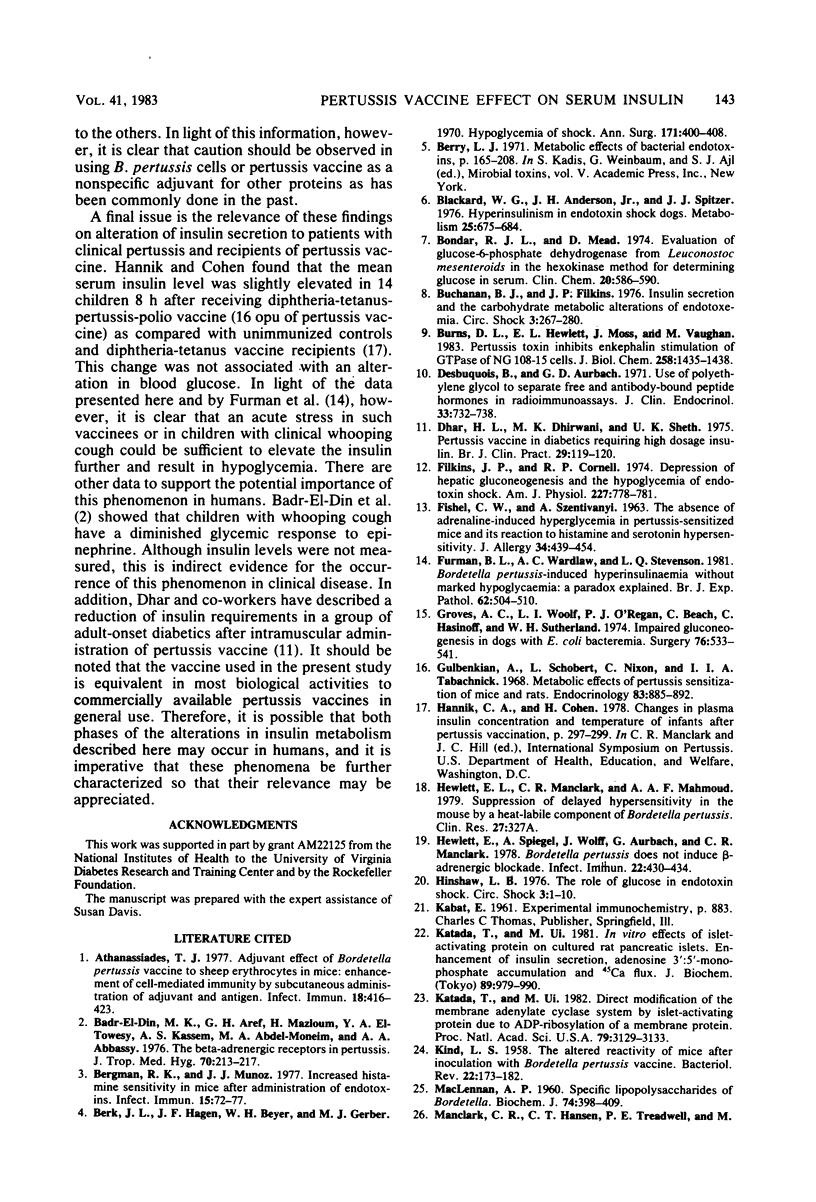
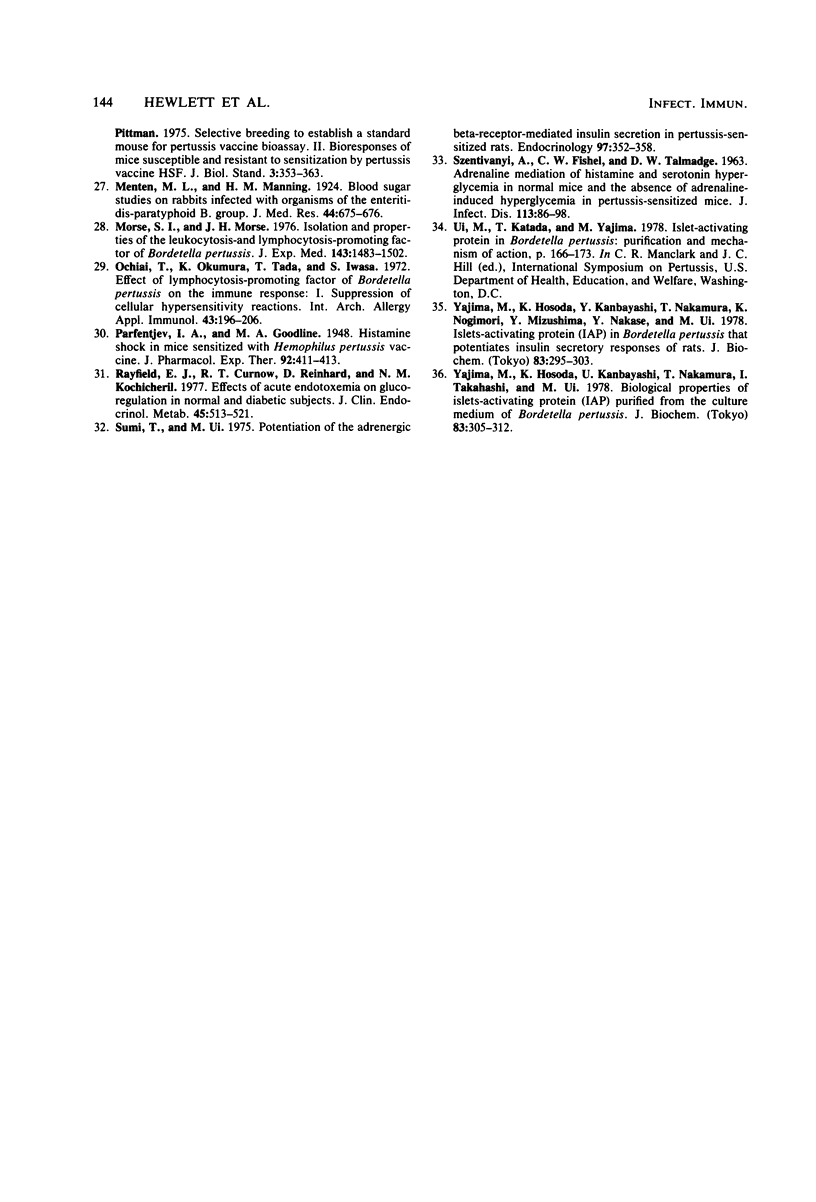
Selected References
These references are in PubMed. This may not be the complete list of references from this article.
- Athanassiades T. J. Adjuvant effect of Bordetella pertussis vaccine to sheep erythrocytes in mice: enhancement of cell-mediated immunity by subcutaneous administration of adjuvant and antigen. Infect Immun. 1977 Nov;18(2):416–423. doi: 10.1128/iai.18.2.416-423.1977. [DOI] [PMC free article] [PubMed] [Google Scholar]
- Badr-El-Din M. K., Aref G. H., Mazloum H., El-Towesy Y. A., Kassem A. S., Abdel-Moneim M. A., Abbassy A. A. The beta-adrenergic receptors in pertussis. J Trop Med Hyg. 1976 Oct;79(10):213–217. [PubMed] [Google Scholar]
- Bergman R. K., Munoz J. J. Increased histamine sensitivity in mice after administration of endotoxins. Infect Immun. 1977 Jan;15(1):72–77. doi: 10.1128/iai.15.1.72-77.1977. [DOI] [PMC free article] [PubMed] [Google Scholar]
- Berk J. L., Hagen J. F., Beyer W. H., Gerber M. J. Hypoglycemia of shock. Ann Surg. 1970 Mar;171(3):400–408. doi: 10.1097/00000658-197003000-00013. [DOI] [PMC free article] [PubMed] [Google Scholar]
- Blackard W. G., Anderson J. H., Jr, Spitzer J. J. Hyperinsulinism in endotoxin shock dogs. Metabolism. 1976 Jun;25(6):675–684. doi: 10.1016/0026-0495(76)90065-2. [DOI] [PubMed] [Google Scholar]
- Bondar R. J., Mead D. C. Evaluation of glucose-6-phosphate dehydrogenase from Leuconostoc mesenteroides in the hexokinase method for determining glucose in serum. Clin Chem. 1974 May;20(5):586–590. [PubMed] [Google Scholar]
- Burns D. L., Hewlett E. L., Moss J., Vaughan M. Pertussis toxin inhibits enkephalin stimulation of GTPase of NG108-15 cells. J Biol Chem. 1983 Feb 10;258(3):1435–1438. [PubMed] [Google Scholar]
- Desbuquois B., Aurbach G. D. Use of polyethylene glycol to separate free and antibody-bound peptide hormones in radioimmunoassays. J Clin Endocrinol Metab. 1971 Nov;33(5):732–738. doi: 10.1210/jcem-33-5-732. [DOI] [PubMed] [Google Scholar]
- Dhar H. L., Dhirwani M. K., Sheth U. K. Pertussis vaccine in diabetics requiring high dosage insulin. Br J Clin Pract. 1975 May;29(5):119–120. [PubMed] [Google Scholar]
- FISHEL C. W., SZENTIVANYI A. THE ABSENCE OF ADRENALINE-INDUCED HYPERGLYCEMIA IN PERTUSSIS- SENSITIZED MICE AND ITS RELATION TO HISTAMINE AND SEROTONIN HYPERSENSITIVITY. J Allergy. 1963 Sep-Oct;34:439–454. doi: 10.1016/0021-8707(63)90009-1. [DOI] [PubMed] [Google Scholar]
- Filkins J. P., Cornell R. P. Depression of hepatic gluconeogenesis and the hypoglycemia of endotoxin shock. Am J Physiol. 1974 Oct;227(4):778–781. doi: 10.1152/ajplegacy.1974.227.4.778. [DOI] [PubMed] [Google Scholar]
- Furman B. L., Wardlaw A. C., Stevenson L. Q. Bordetella pertussis-induced hyperinsulinaemia without marked hypoglycaemia: a paradox explained. Br J Exp Pathol. 1981 Oct;62(5):504–511. [PMC free article] [PubMed] [Google Scholar]
- Groves A. C., Woolf L. I., O'Regan P. J., Beach C., Hasinoff C., Sutherland W. H. Impaired gluconeogenesis in dogs with E. coli bacteremia. Surgery. 1974 Oct;76(4):533–541. [PubMed] [Google Scholar]
- Gulbenkian A., Schobert L., Nixon, Tabachnick I. I. Metabolic effects of pertussis sensitization in mice and rats. Endocrinology. 1968 Oct;83(4):885–892. doi: 10.1210/endo-83-4-885. [DOI] [PubMed] [Google Scholar]
- Hewlett E., Spiegel A., Wolff J., Aurbach G., Manclark C. R. Bordetella pertussis does not induce beta-adrenergic blockade. Infect Immun. 1978 Nov;22(2):430–434. doi: 10.1128/iai.22.2.430-434.1978. [DOI] [PMC free article] [PubMed] [Google Scholar]
- KIND L. S. The altered reactivity of mice after inoculation with Bordetella pertussis vaccine. Bacteriol Rev. 1958 Sep;22(3):173–182. doi: 10.1128/br.22.3.173-182.1958. [DOI] [PMC free article] [PubMed] [Google Scholar]
- Katada T., Ui M. Direct modification of the membrane adenylate cyclase system by islet-activating protein due to ADP-ribosylation of a membrane protein. Proc Natl Acad Sci U S A. 1982 May;79(10):3129–3133. doi: 10.1073/pnas.79.10.3129. [DOI] [PMC free article] [PubMed] [Google Scholar]
- Katada T., Ui M. In vitro effects of islet-activating protein on cultured rat pancreatic islets. Enhancement of insulin secretion, adenosine 3':5'-monophosphate accumulation and 45Ca flux. J Biochem. 1981 Apr;89(4):979–990. [PubMed] [Google Scholar]
- MACLENNAN A. P. Specific lipopolysaccharides of Bordetella. Biochem J. 1960 Feb;74:398–409. doi: 10.1042/bj0740398. [DOI] [PMC free article] [PubMed] [Google Scholar]
- Manclark C. R., Hansen C. T., Treadwell P. E., Pittman M. Selective breeding to establish a standard mouse for pertussis vaccine bioassay. II. Bioresponses of mice susceptible and resistant to sensitization by pertussis vaccine HSF. J Biol Stand. 1975;3(4):353–363. doi: 10.1016/0092-1157(75)90060-8. [DOI] [PubMed] [Google Scholar]
- Morse S. I., Morse J. H. Isolation and properties of the leukocytosis- and lymphocytosis-promoting factor of Bordetella pertussis. J Exp Med. 1976 Jun 1;143(6):1483–1502. doi: 10.1084/jem.143.6.1483. [DOI] [PMC free article] [PubMed] [Google Scholar]
- Ochiai T., Okumura K., Tada T., Iwasa S. Effect of lymphocytosis-promoting factor of Bordetella pertussis on the immune response. I. Suppression of cellular hypersensitivity reactions. Int Arch Allergy Appl Immunol. 1972;43(2):196–206. doi: 10.1159/000230837. [DOI] [PubMed] [Google Scholar]
- Rayfield E. J., Curnow R. T., Reinhard D., Kochicheril N. M. Effects of acute endotoxemia on glucoregulation in normal and diabetic subjects. J Clin Endocrinol Metab. 1977 Sep;45(3):513–521. doi: 10.1210/jcem-45-3-513. [DOI] [PubMed] [Google Scholar]
- SZENTIVANYI A., FISHEL C. W., TALMAGE D. W. ADRENALINE MEDIATION OF HISTAMINE AND SEROTONIN HYPERGLYCEMIA IN NORMAL MICE AND THE ABSENCE OF ADRENALINE-INDUCED HYPERGLYCEMIA IN PERTUSSIS-SENSITIZED MICE. J Infect Dis. 1963 Sep-Oct;113:86–98. doi: 10.1093/infdis/113.2.86. [DOI] [PubMed] [Google Scholar]
- Sumi T., Ui M. Potentiation of the adrenergic beta-receptor-mediated insulin secretion in pertussis-sensitized rats. Endocrinology. 1975 Aug;97(2):352–358. doi: 10.1210/endo-97-2-352. [DOI] [PubMed] [Google Scholar]
- Yajima M., Hosoda K., Kanbayashi Y., Nakamura T., Nogimori K., Mizushima Y., Nakase Y., Ui M. Islets-activating protein (IAP) in Bordetella pertussis that potentiates insulin secretory responses of rats. Purification and characterization. J Biochem. 1978 Jan;83(1):295–303. doi: 10.1093/oxfordjournals.jbchem.a131904. [DOI] [PubMed] [Google Scholar]
- Yajima M., Hosoda K., Kanbayashi Y., Nakamura T., Takahashi I., Ui M. Biological properties of islets-activating protein (IAP) purified from the culture medium of Bordetella pertussis. J Biochem. 1978 Jan;83(1):305–312. doi: 10.1093/oxfordjournals.jbchem.a131905. [DOI] [PubMed] [Google Scholar]


